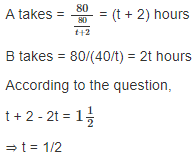Solutions
Alternate Method
Shortcut Trick
Let, time taken by B = t hours and, A = t + 2
Now, the speed of B = 40/t kmph and the speed of A = 40/(t + 2) kmph
We know, Distance = Speed × time
To travel a distance of 80 km A doubles his speed
Time taken by A to cover 40 km distance = t + 2 hours, where t is the time taken by B to cover the distance.
Time taken by A to cover the 40 km distance when its speed is double = Time taken to cover 80 km distance/2 = (2t + 3/2)/2 = t + 3/4
Distance = (S1 × S2)/(S1 - S2) [Time difference]
Here, S1 = x, S2 = 2x (For A)
40 = 2x × x/(2x - x)[t + 2 - t - 3/4]

Now B takes 1/2 hours to cover 40 km

⇒ 40 = 2x(5/4)
⇒ x = 16
Actual time taken by A = 40/16 = 2.5 hours
Actual time taken by B = 2.5 - 2 = 0.5 hour
Speed of B = 40/0.5 = 80 km/h
Required time taken by B = 120/80 = 3/2 hours
Traditional method:
Given:
A takes 2 hours more than B to cover a distance of 40 km
When A doubles his speed, he takes 1.5 hours more than B to travel 80 km
Concept used:
Distance = Speed × Time
Calculation:
Let The speed B be x km/h.
Time taken by B to cover 40km = 40/x hour
Time taken by A to cover 40km = [(40/x) + 2] hour
Speed of A = (40)/[(40 + 2)/x] kmph
⇒ (20x)/(20 + x) kmph ……… (1)
Now,
Time taken by B to cover 80 km = 80/x hour
When A doubles his speed = (40x)/(20 + x) kmph
Time taken by A to cover 80 km = 80/(40x)/(20 + x)
⇒ (40 + 2x)/x hour
Now in this case,
A takes 1.5 hour more than B to travel 80 km
So,
⇒ (40 + 2x)/x - 80/x = 3/2
⇒ (40 + 2x - 80)/x = 3/2
⇒ 4x - 80 = 3x
⇒ x = 80
So,
Speed of B is 80 kmph.
Now,
To cover a distance of 120 km, B will take
⇒ 120/80 = 1.5 hours
∴ To cover a distance of 120 km, B will take 1.5 hours.



 Get latest Exam Updates
Get latest Exam Updates 





 ×
×






